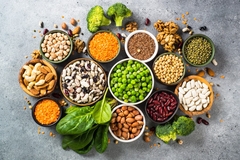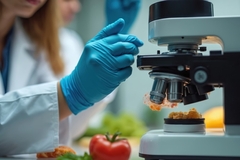
- Industry news
Industry news
- Category news
Category news
- Reports
- Key trends
- Multimedia
- Journal
- Events
- Suppliers
- Home
- Industry news
Industry news
- Category news
Category news
- Reports
- Key trends
- Multimedia
- Events
- Suppliers
Scientists create tech-smart food that “dances” on the plate to revolutionize dining
12 Oct 2023 --- Researchers are poised to transform the future food experience with “computational food” that dances across the plate powered by technology that makes its move. The system, dubbed “Dancing delicacies,” programs and configures food items like sauces and condiments, to create new combinations using a plate fitted with electrodes.
The new study aims to provide playful and interactive culinary opportunities for diners and chefs and encourage researchers and designers to envision a future of “human-food interaction.”
The scientists have designed a plate that embeds “electrowetting on dielectric” technology to execute precise motion operations of aqueous droplets. Electrical voltage is used to unbalance the force equilibrium at the solid-liquid-vapor interface, which makes the droplets move toward the charged electrodes.

The food can only move on the “dielectric surface attached to the plateware” the scientists have designed, at a speed that depends on the ingredients, the liquid food’s thickness and the software’s programming.
Jialin Deng, food interaction design researcher and lead author of the research at Monash University, Australia, tells Food Ingredients First: “Human-Food Interaction (HFI) is a new area within the broader field of Human-Computer Interaction (HCI). Thanks to modern computing technology, we’re seeing exciting changes in how we make, cook and eat food.”
“Our research hopes to pave a path for designing tech-smart food and point out exciting new directions for food experiences and ultimately, to spark more innovation in the food and drink world.”
Monash University’s Faculty of Information Technology conducted the research, supported by the Australian Research Council in collaboration with Worksmith.
Innovating with chefs
Partnering with Morphing Matter Lab at Carnegie Mellon University in the US and Gaudi Labs in Switzerland to build the initial Dancing Delicacies system, the team worked with professional chefs and food experts to craft innovative dishes and delve into the dining experiences.
 "Yin & Yang," was one of the dishes in which the scientists experimented with black and white sauces (Image Credit: Monash University).“So far, we brought two new dishes into reality: "Yin & Yang," a dish with contrasting black and white sauces that capture the essence of balance between opposing forces and "A Taste Ballet”, a choreographed medley of flavors that takes the diner on a sensory journey, harmoniously converging to create a memorable crescendo,” says Deng.
"Yin & Yang," was one of the dishes in which the scientists experimented with black and white sauces (Image Credit: Monash University).“So far, we brought two new dishes into reality: "Yin & Yang," a dish with contrasting black and white sauces that capture the essence of balance between opposing forces and "A Taste Ballet”, a choreographed medley of flavors that takes the diner on a sensory journey, harmoniously converging to create a memorable crescendo,” says Deng.
The researchers flag that the study can support the hospitality industry in bringing unique dining experiences to their customers, offering something that cannot be home-delivered.
“In terms of this research, we envision various novel and engaging dining experiences in working with the restaurants and creative chefs and F&B brands.”
An interesting example Deng cited is how chefs can predefine the locations where they want to put the food droplets and ingredients in a dish and program the dish frame by frame, similar to animation.
She added that combining solid and watery items makes it possible to merge two different flavors. “We can transport various things toward the plate and play with chemical or physical reactions like in molecular gastronomy.”
The researchers also conducted co-design workshops with chefs to give them a chance to experiment with the system by crafting authentic dishes.
Matthew Birley, Monash club head chef, deemed the concept a “new path” for chefs in culinary experimentation. “We really start to interact with the feelings and movements of the diner. I think this can have a great impact on what we can do as chefs in the dining industry.”
Making it work
The scientists had been working on the prototype for about a year.
 The team used “electrowetting on dielectric” technology to move aqueous droplets (Image Credit: Monash University).“Since this is a new field, it’s a bit scattered, making it hard for designers and culinary practitioners to fully dive in,” says Deng.
The team used “electrowetting on dielectric” technology to move aqueous droplets (Image Credit: Monash University).“Since this is a new field, it’s a bit scattered, making it hard for designers and culinary practitioners to fully dive in,” says Deng.
“One of our main challenges was dealing with food materials in the system. Technically, our system can only move liquids. But with creative design, we found ways for liquid items to interact with solids, like using droplets to carry a basil leaf.”
Another challenge was finding a balance between making the dish palatable and making it work computationally. To overcome this, the team collaborated with chefs for valuable insights on striking the right balance in computational food and with specialists from material science, hardware and software engineering and electrowetting to devise the system.
The system allows chefs to tell “richer stories” with their dishes, like presenting varied dishes to different diners to accommodate dietary restrictions and preferences.
Meanwhile, merging culinary arts with technology has also caught the attention of food companies worldwide. Some, like South Korean start-up Robo Arete, are beginning to use it to solve issues like labor shortages by employing robotics to cook its fried chicken.
Intersection of food science and computing
The university depicts the research as an intersection of food science, human-computer interaction and computational technology.
According to Deng, the innovation has real-world applications, such as boosting family and children's engagement or providing a fun, educational tool in food and computer science education.
 The study envisions a new future of “human-food interaction.”Professor Florian ‘Floyd’ Mueller, interaction, game and play design expert from the faculty of IT’s creative technologies discipline group and co-author of the research, flags that the research is a glimpse into the future.
The study envisions a new future of “human-food interaction.”Professor Florian ‘Floyd’ Mueller, interaction, game and play design expert from the faculty of IT’s creative technologies discipline group and co-author of the research, flags that the research is a glimpse into the future.
“The integration of food and computing will transform how we understand both computing and food as not two very different things, but a new frontier that combines the best of both.”
Looking ahead
While the technology allows efficient manipulation of droplets, it also limits the food materials to aqueous forms, acknowledge the researchers. The qualities of food droplets (surface tension and viscosity) decide if the movement is possible.
“Future explorations around other technologies might offer more possibilities,” underscore the scientists.
The team’s vision for the future of developing the Dancing delicacies system includes applications in flavor experimentation, home food testing, precise micro-cooking on the plate and facilitating remote interactions for shared dining experiences.
“We hope that with further optimization, we can host dining experience events to share our innovations with the wider community,” concludes Deng.
By Insha Naureen












